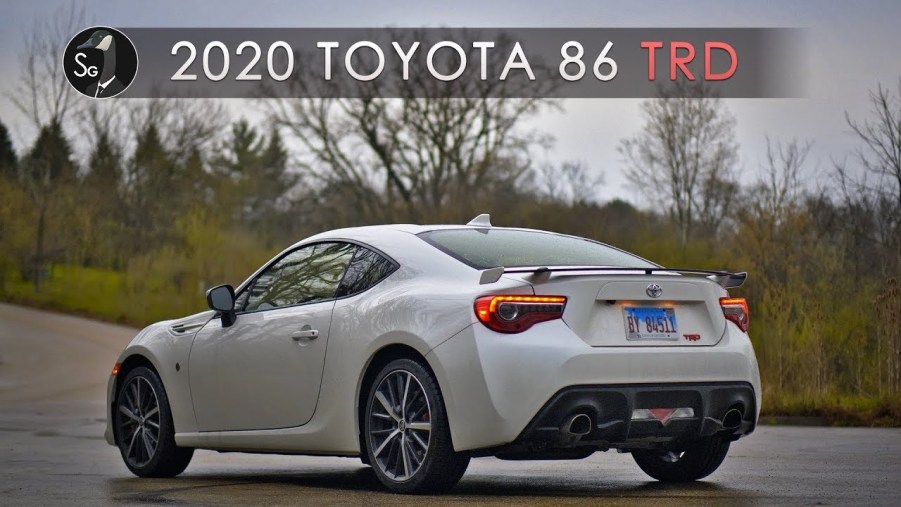
Say Goodbye to the Toyota 86 with This Gorgeously Shot Video Review
Sharing its name with a beloved JDM icon, the Toyota 86, aka Subaru BRZ, was the first sign Toyota was seriously embracing performance once more. True, some critics complained about a lack of power. However, like the Miata, the 86’s true qualities weren’t based on outright speed. But, with a refreshed version on the horizon, YouTube team SavageGeese wanted to take one last look at the affordable sports car.
What SavageGeese enjoyed about the 2020 Toyota 86
SavageGeese and his co-host, Jack, actually met because they both owned earlier versions of the Toyota 86. Jack owned a BRZ, and SavageGeeze a Scion FR-S. And both remark that, over 86’s 7 years on the market, it has improved in some ways.
Initially, the BRZ was a bit more luxurious. Now, though, the Toyota 86 has closed the gap. Apple CarPlay and Android Auto are standard, and you can spec heated seats. And in 2017, Car and Driver reports, the 2.0-liter flat-four gained 5 hp and 5 lb-ft to put out 205 hp and 156 lb-ft. The transmission was also revised, cutting about 0.2 seconds from the 0-60 time. But again, straight-line speed isn’t the Toyota 86’s game.

Rather than adding power, Toyota focused on improving handling. Initially, SavageGeese and Jack report, the FR-S was noticeably more tail-happy than the BRZ. Now, though, the two are almost equally neutral in handling. Especially with the optional TRD Handling Package, which adds Sachs dampers, Brembo brakes, rear sway bar, and stickier summer tires,

The shifter, steering, and overall ergonomics, though didn’t need to be improved. Jack claims that the 86 has the best steering in a sub-$50,000 car. And on the street, compared with an equally-expensive ND Miata, the Toyota is more satisfying to drive. It’s less floaty and has less body roll. But with the Sachs dampers, it still rides smoothly. Plus, with its larger trunk and foldable rear seats, the 86 is genuinely more practical.
Unfortunately, it still needs some work.
Where it needs improvement

Although the Toyota 86 has gotten more features, Car and Driver reports the interior still feels somewhat cheap. SavageGeese and Jack concur, and also report the bolstered seats don’t breathe terribly well.
In addition, although the 86 handles better than the ND on the street, the Miata is the better track car. Its suspension is better-engineered and responds better to modification. In addition, the Mazda can rotate under braking, which is very desirable, especially for autocross. The Toyota, though, can’t really do that. Both have more grip than power, which is good for learning driving dynamics. But in the Miata, the driver can better modulate the grip.
And speaking of power, the Toyota 86’s engine is still flawed. Not just because of power output, but how it delivers that power. For one, it still has a noticeable torque dip in the middle of the rev range. So, you have to rev it almost to redline to get the best performance. But the non-linear performance, and harsh engine sound, don’t fit the 86’s character.
Will the next-gen Toyota 86 resolve these issues?
Luckily, Motor Trend reports, the next-gen Toyota 86 may fix some of these problems.
Firstly, it will get a name change, to the Toyota GR 86. GR, aka Gazoo Racing, is Toyota’s in-house performance division, responsible for the AWD GR Yaris and upcoming Corolla hot hatch. So, while the next-gen car won’t reach Supra levels of performance, it will remain suitably sporty.
Additionally, Subaru and Toyota may finally give their cars a turbo. Motor1 reported the next-gen model will use a 217-hp 2.4-liter naturally-aspirated flat-four. However, MT claims it will instead use a modified version of the Subaru Ascent’s engine. In the Ascent, the 2.4-liter turbocharged flat-four makes 260 hp and 277 lb-ft.
To be sure, Toyota and Subaru could have theoretically given the current-gen car a turbo. The Drive reports the 86’s engine is basically the current-gen WRX’s engine minus a turbo. However, in an interview with Road & Track, the 86’s chief engineer claimed adding power would’ve required a new platform.
There may be another reason for adding a turbocharger than just power, though. Adding a turbo, Carwow explains, boosts low-end torque. And when R&T put the current-gen WRX and WRX STI on its dyno, the NA version’s torque dip was nowhere to be seen.
Goodbye for now, then, Toyota 86. We hope to see the new you soon.
Follow more updates from MotorBiscuit on our Facebook page.


